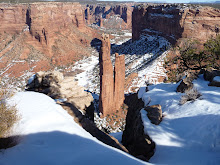I wanted to finish my observations on the Long Walk book that I summarized yesterday. It was interesting to me that there seemed to be some formulas that the stories followed, and I'd love to know how that came to pass. Won't ever know, I'm sure, because the stories were collected almost 40 years ago from people who were elderly then. And I don't intend to become a scholar of Native Americana, although I'll always have some interest.
There were three or four of the stories that concerned women being taken by other tribes or Mexicans as slaves and then escaping, and one concerning a woman who set out on her own after escaping from Ft. Sumner. In every one of these stories, but none that I remember about men, a wild bird or animal was said to have guided the women back to their families. Owls, coyotes, and in one case a bear, caught the attention of each woman, who followed until they were in familiar territory. Once near home, the women who had been slaves had to undergo a purification ceremony before being allowed back into the dwellings.
The majority of the storytellers explained that their ancestors had brought the disaster on themselves because of their raiding, stealing and killing. A few said they weren't thieves, and were indignant that the entire tribe was punished for the transgressions of a few. The same storyteller might say at a different time that the government in Washington had decided that the tribe should be saved and not be wiped out, and that's why they were taken to Ft. Sumner to protect them from their enemies. There was, however, an overwhelming sense that their memories were of poverty, near starvation, and being beset by enemies on all sides.
I had to keep remembering that the values of present-day civilized society were not necessarily shared even by our own ancestors, much less by a people whose mere survival depended on being able to get food wherever they found it, by whatever means necessary. Some of the storytellers told matter-of-factly about raiding parties obtaining sheep, cattle and horses. Others said that their ancestors traded wool and woven blankets for their livestock. Still, the livestock that they were dependent upon weren't native to this land, so they had to get the original stock somehow. Due to their poverty, that almost certainly came from raiding.
One story has really stuck in my mind, possibly because the original party set out to trade far north, all the way to Salt Lake City. They had passed through an area that had a few houses made of wood and some fields nearly ready for harvest. There was also a stone house, evidently abandoned, where they took shelter on the way north. Arriving back at the same place on their way home, they noticed that only the stone house was still standing, the others had been burned to the ground. The storyteller, somewhat disingenuously said that the trading party wondered if their carelessness with their fire had caused this, and that they were wary lest other Whites in the area blame them for it. Apparently they did, because the house was attacked, and four of the trading party killed there. The others, one by one, made attempts to leave the house and escape on horses, including one 'fat white' one that belonged to the attacking Whites.
At this point, the story began to sound almost like the three little pigs, as the last person to leave the house (the storyteller's grandfather--who could have been any male member of his clan from that generation) took the white horse and, though wounded in the back, overtook the previous three. As he came to each one, the other person was near death, and begged the escapee on the white horse to kill the other's horse so as to deny it to the pursuing whites. Three times this happened, and then the last escapee lost consciousness, only to be found by members of his family who had come to look for him.
In retaliation, once he was recovered, the sole survivor took a band of three or four men to go back and kill the attacking whites. Coming upon a house with two men, two women and three children, they killed all of the occupants and decided that this was enough retaliation for the seven Navajo who had been killed. It's hard to know whether to take this story literally, when it sounds almost like a Brothers Grimm formula. If we are to do so, though, it's the height of irony that the innocent family was killed in place of the attackers and in the next few minutes the storyteller was complaining of the treatment of the Navajos in rounding up the whole tribe for the crimes of a few.
Last observation: the sequence of events and even the flow of time in these stories is very confusing. Whether it is true of the members of the tribe today or not, these Navajo storytellers were not at all concerned about those details, but were very precise as to the location where the events took place. This entire region is crisscrossed by the trails of memory in these stories. I'm looking forward to the ground drying out a little so we can walk where they walked.

No comments:
Post a Comment